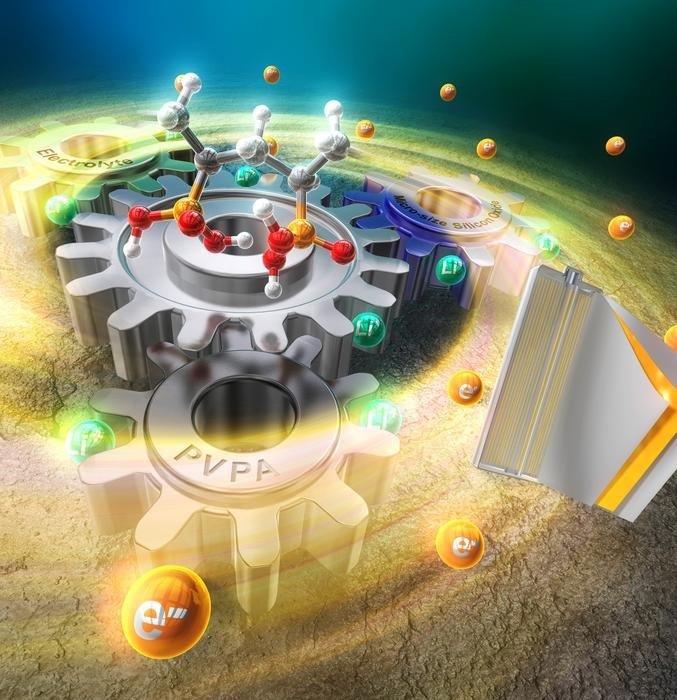Although lithium-ion batteries are widely used in many different applications, their performance needs to be improved to meet changing demands. This is because silicon oxide (SiO), which is a promising anode material due to its low cost and high capacity, has several drawbacks.
 Researchers have engineered a high-performance binder for micro-silicon oxide (SiO)-based electrodes within lithium-ion batteries with poly (vinylphosphonic acid) (PVPA), which enhances electrochemical performance and durability compared to conventional options. Image Credit: Noriyoshi Matsumi from JAIST
Researchers have engineered a high-performance binder for micro-silicon oxide (SiO)-based electrodes within lithium-ion batteries with poly (vinylphosphonic acid) (PVPA), which enhances electrochemical performance and durability compared to conventional options. Image Credit: Noriyoshi Matsumi from JAIST
These include substantial expansion during charging and poor conductivity, which results in slower charging rates. Therefore, to solve these problems and guarantee improved performance and extended durability for lithium-ion battery systems, effective binders are crucial.
Professor Noriyoshi Matsumi of the Japan Advanced Institute of Science and Technology (JAIST), Doctorate Student Noriyuki Takamori, Former Senior Lecturer Rajashekar Badam, Former Student Dr Tejkiran Pindi Jayakumar, and researchers from Maruzen Petrochemical Company Ltd. used poly (vinylphosphonic acid) (PVPA) as a binder for micro-SiO electrodes, achieving superior performance compared to conventional cells. This research was published in the journal ACS Applied Energy Materials on February 8th, 2024.
The PVPA binder should prove to be very useful in extending the life of high-performing lithium-ion secondary batteries. Particularly in the application of electric vehicles, there has been intense interest in enabling long life for lithium-ion secondary batteries. The use of PVPA will offer improved alternatives to commercially available binders, such as poly (acrylic acid) (PAA) and poly (vinylidene fluoride) (PVDF), etc.
Noriyoshi Matsumi, Professor, Japan Advanced Institute of Science and Technology
Density functional theory and electrochemical experiments were used to evaluate the performance of electrodes made with PVPA, PAA, and PVDF as binders in the study. Compared to traditional PAA (2.03 N/m), PVPA showed noticeably stronger adhesion (3.44 N/m) to copper support, which greatly increased lithium-ion battery durability.
After 200 cycles, the PVPA-based cell exhibited nearly twice the discharging capacity compared to the PAA-based cell. The PVPA-based half-cell achieved 1300 mAhg-1SiO after the same number of cycles.
Unlike PVDF or PAA binders, exfoliation from the current collector was not seen in scanning electron microscopy, even after 200 charge-discharge cycles. Additionally, even with significant volume expansion, the SiO-based anode is stabilized by the stronger adhesion of PVPA, which prevents its exfoliation.
Furthermore, an industrial manufacturing procedure for PVPA has been devised by Maruzen Petrochemical Company Ltd., whose researchers participated in the study. Ongoing cooperation between JAIST and Maruzen Petrochemical Company Ltd., in addition to the incorporation of extra battery production expertise from the company, might expedite the path toward practical implementations.
The technology has been the subject of joint patent applications by JAIST and Maruzen Petrochemical Company Ltd., filed both domestically (in Japan) and internationally.
Matsumi added, “An industrially feasible, high-performing binder like this will aid in the development of technology for highly durable and high-energy-density batteries. This will result in the wider adoption of EVs worldwide without concerns about performance degradation over a longer period. These materials can also be applicable to a variety of electric vehicles such as trains, ships, aircraft, etc., in the future.”
In conclusion, researchers have created a functional binder for SiO-based anodes in lithium-ion batteries using poly (vinylphosphonic acid). This inexpensive binder is a novel advancement for micro-SiO-based applications in electric vehicles and other fields, and it performs better than traditional options.
Journal Reference:
Takamori, N., et al, (2024) Facile Stabilization of Microsilicon Oxide Based Li-Ion Battery Anode Using Poly (vinylphosphonic acid). ACS Applied Energy Materials. doi.org/10.1021/acsaem.3c02127.